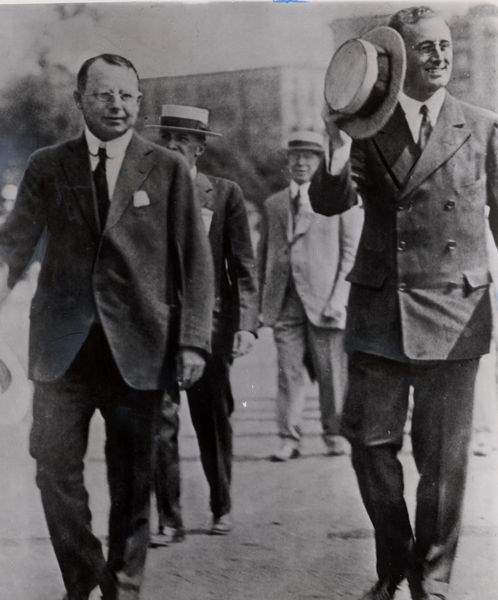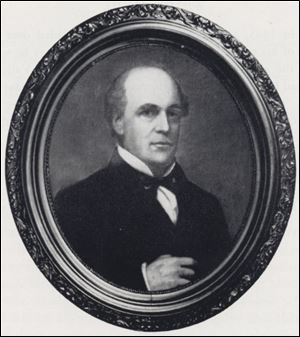
Most were little known outside state
3/2/2003
James M. Cox, left, served as governor from 1913 to 1915 and from 1917 to 1921. In 1920, he ran unsuccessfully for president. His running mate was Franklin D. Roosevelt, right.
ap

James M. Cox, left, served as governor from 1913 to 1915 and from 1917 to 1921. In 1920, he ran unsuccessfully for president. His running mate was Franklin D. Roosevelt, right.
COLUMBUS — Ohio sent two governors to the White House and many more to Congress. One was the chief justice of the United States who presided over the impeachment trial of President Andrew Johnson.
But few of Ohio's 67 governors — from Democrat Edward Tiffin in 1803 to Republican Bob Taft today — are known much beyond Ohio's history books or its borders.
“Governors in Ohio were in a weak political position,” said George Knepper, history professor emeritus at the University of Akron.
“For a governor to receive national visibility even 100 years ago, he had to be a special case,” he said. “Ohio's governors, on the whole, were caretakers.”
The first “caretaker,” Edward Tiffin, a Democrat serving 1803-07, is remembered more for helping Ohio take its first steps toward statehood than for any accomplishments as its first chief executive.
Born in England, he settled in Chillicothe, where he rebelled against Arthur St. Clair, the governor of the Northwest Territory, by speaking out in favor of statehood.
He served as president of the 1802 constitutional convention that preceded Ohio's entry into the union on March 1, 1803.
It was Ohio's sixth governor, Tiffin's brother-in-law Thomas Worthington, 1814-18, who was the first to try to shake things up. Also from Chillicothe, he had served as one of Ohio's first two U.S. senators before becoming governor.
“There were governors, like presidents, who are better known because they tended to be polarizing,” said Andrew Cayton, history professor at Miami University and author of Ohio: The History of a People.

Chase: He was anti-slavery.
“One of the first was Thomas Worthington, a very controversial figure,” he said. “Worthington was interested in a more democratic state than a lot of people wanted. There were controversies about whether the legislature should have power over the courts in Ohio.”
Robert Lucas, serving 1832-36, stamped his name forever on northwest Ohio when he fought to hold onto a strip of land along the Maumee River for Ohio during the Ohio-Michigan border dispute of 1835. He later become governor of the Iowa territory as it approached statehood.
Among Ohio's most-intriguing governors was Salmon P. Chase, 1856-60, one of the founders of the new Republican Party and Ohio's first Republican governor.
A Cincinnati lawyer, he had defended runaway slaves.
“He was very committed to the anti-slavery movement,” said Mr. Cayton. While in the U.S. Senate, Chase worked to bring abolition to the forefront of his fledgling party.
After Chase removed his name from consideration for the Republican nomination for president in 1860, paving the way for Abraham Lincoln to be nominated, Lincoln returned the favor by naming him secretary of the Treasury.
Lincoln later appointed Chase chief justice of the United States.
Chase swore in Andrew Johnson as president after Lincoln's assassination and presided over Johnson's subsequent impeachment trial.
The last half of the 19th century saw Ohio governors ascend to the White House. Rutherford B. Hayes, the first governor to be elected three times, served from 1868-72 and again from 1876-77.
“Ohio was in those years very evenly divided between Democrats and Republicans and was the third most populous state in the nation,” said Mr. Knepper. “The only way to ensure Ohio's electoral votes [for president] was to have a favorite son.”
A champion of civil rights early in his career, Hayes was accused of abandoning those principles in order to become president.
His election was tainted when he didn't win the popular vote, and he was eventually elected by a congressional commission by a one-vote margin. As part of the deal, one of Hayes' first acts was to withdraw federal troops from the South, setting back the cause of civil rights.
William McKinley, Republican governor from 1892-1896, was Ohio's second and last governor to become president.
Perhaps best known for his assassination, he led the country during the Spanish-American War.
While in Congress, he became a leader in establishing tariffs on foreign goods to protect American manufacturers.
Considered one of the most influential governors in state history, James M. Cox, a Democrat who served from 1913-15 and 1917-21, came to power just as the Progressive Movement was cresting in Ohio.
The Constitutional Convention of 1912 resulted in voter approval of constitutional changes affecting government and social services, among them ballot initiative, home rule, and mandatory workers compensation.
“It's one thing to change the constitution,” said Mr. Knepper. “It's another for the statute law to be passed. James Cox, the Dayton Daily News publisher, took the initiative to make sure the state legislature pushed hard on the law to make the changes effective.”
Cox ran for president in 1920, losing to another Ohioan, Warren G. Harding, owner of the Marion Star.
Another presidential contender was John W. Bricker, a Republican who served as governor from 1939-45.
The former attorney general from suburban Columbus served during World War II, emerging as a political foe to popular New Deal President Franklin D. Roosevelt.
Criticizing the growing federal bureaucracy, he sought the GOP presidential nomination in 1944 but settled for the vice presidential nod under Thomas E. Dewey. Roosevelt won an unprecedented fourth term.
The only Ohio governor to serve five terms, albeit two-year terms, was Frank J. Lausche, a charismatic Cleveland Democrat, judge, mayor, and anti-gambling crusader who served from 1945-47 and again from 1949-57.
“He was very conservative,” said Mr. Knepper. “Republicans loved him and voted for him. He had a penny-pinching attitude, and Ohio has always responded well to that.”
It took nearly 30 years, but James A. Rhodes, a Republican, eventually eclipsed Lausche's 10-year run at the top, serving four four-year terms from 1963-71 and 1975-83. He remains Ohio's longest-tenured governor. The term length was increased from two years to four years in 1959.
Governor Rhodes is renowned in Ohio as the father of the state's two-year college system. But he will be forever linked in the national consciousness with his decision to send the National Guard to Kent State University to quell an anti-Vietnam demonstration in 1970. Four students died.